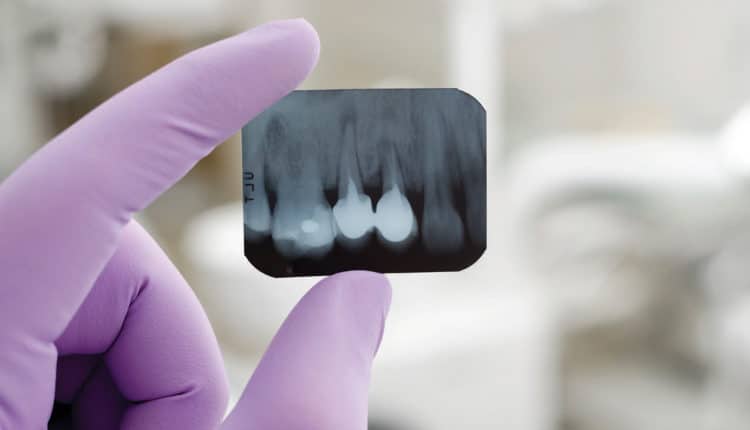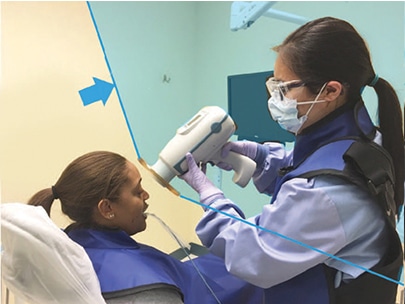 MILOSLJUBICIC/ISTOCK/GETTY IMAGES PLUS
MILOSLJUBICIC/ISTOCK/GETTY IMAGES PLUS
Technique Tips for Handheld Radiography
Appropriate training and keeping up to date on research are key to ensuring the safe and effective use of a handheld X-ray device.
Handheld, portable dental X-ray devices, or handhelds, have gained popularity over the past few years because they enable operators to simultaneously hold the device while exposing radiographic images. In contrast, when using wall-mounted dental X-ray units, the operator must leave the room to make the X-ray exposure, maintaining a safe distance from the source of radiation. Handhelds are ideal for use in situations where wall-mounted dental X-ray devices are not accessible, such as mobile dental clinics and outreach events where midlevel dental hygiene practitioners may provide oral hygiene assessment and treatment.1 In addition, handhelds are useful in emergency situations of mass fatality incidents for disaster victim identification.2
SAFETY

decreased vertical angulation from 0°.
Handhelds are equipped with a backscatter ring shield around the position indicating device (PID) and inherent shielding to keep the operator in the “zone of protection” from resulting backscatter radiation that may be produced during dental X-ray exposures. Current research validates the safety surrounding handheld units cleared by the United States Food and Drug Administration (FDA); no additional radiation risk to the operator has been found when using handheld X-ray equipment when all required safety protocols are followed.3
A 2014 study on handhelds found that devices not cleared by the FDA led to an increased radiation dose to both the patient and operator, as operator shielding and collimation of the primary X-ray beam were not adequate.4 Handheld equipment must have inherent shielding, additional shielding around the PID, and an affixed backscatter ring shield. Handhelds should never be used if the backscatter ring shield is defective, not affixed to the PID, or broken.
Radiographers may also don a lead apron with attached thyroid collar to eliminate any possible scatter radiation exposure from suboptimal positioning of the handheld device and backscatter ring. In addition, some state regulatory boards require operators of handheld radiographic equipment to wear a dosimeter badge to measure the amount of radiation received within a specific preset period, such as weekly or monthly. However, dosimeter badges do not directly protect the operator from ionizing radiation exposure because levels of radiation are found after the badge is assessed. After the dosimeter badge readings are analyzed, the operator may realize that additional protective measures and precautions are necessary.
To further minimize radiation exposure when using handhelds, exposure settings such as milliamperage (mA), exposure time, and kilovoltage (kV) settings should be changed depending on the bone density of the area being imaged, similar to the use of a wall-mounted dental X-ray unit. High density areas within the oral cavity (posterior regions) will require increased exposure settings, while lower density areas will require decreased exposure settings (anterior region).5 Manufacturers of handheld X-ray devices may recommend appropriate exposure settings based on the type of image receptor used (direct digital sensor, phosphor plate, or film); teeth being imaged; location within the oral cavity (maxilla or mandible); and patient size (adult or child). Overall, exposure settings can be set lower for digital sensors and higher for phosphor plates and film, respectively.
Radiographers using handheld radiographic equipment should be knowledgeable on the lowest exposure settings needed to produce an acceptable image and be able to apply safe practices for the operator and patient.
TECHNIQUE

position upward for mandibular periapical images or
downward for maxillary periapical images.
The operator must follow manufacturer instructions for optimal radiation safety when using handheld X-ray devices. One of the directions for safe use of handhelds is to hold the device at the operator’s mid-torso height for all exposures. However, holding the device at mid-torso height requires a vertical angulation of approximately 0° (with the device parallel to the floor), which is not possible to maintain for all types of dental radiographs. Periapical images require steep increased or decreased vertical angulation from 0°, which would place the operator at risk for radiation exposure to critical organs and out of the “zone of protection” given by the backscatter ring shield of the handheld device (Figure 1).
To follow manufacturer directions and reduce possible operator radiation exposure when using handhelds, the patient should be instructed to move his or her head position upward for mandibular periapical images or downward for maxillary periapical images, instead of keeping the patient’s occlusal plane parallel to the floor and mid-sagittal plane perpendicular to the floor (Figure 2).
The operator must stand directly behind the handheld device during the exposure for optimal protection with the backscatter ring shield, which makes the visualization of accurate angulations necessary to achieve quality images difficult. Also, because the patient’s head will not be in the usual position for exposing radiographs and tilted either higher or lower for operator safety, accurate angulations for effective technique will be more difficult to determine.
The use of image receptor holding devices is beneficial to assist the operator with accurate positioning of the PID; however, the backscatter ring shield interferes with the metal extension arm of the image receptor holding device. Manufacturers of holding devices have shortened the metal positioning arm for use with handheld radiographic equipment; therefore, altered equipment should be used together with handheld devices.
CONCLUSION
With the increased use of handheld X-ray devices, operators need to understand the necessary alterations and safety mechanisms for radiation safety and protection. In order to receive the maximum benefit of handheld devices while minimizing operator scatter radiation, all safety precautions must be followed. Proper technique is vital, as scatter radiation is reduced if the operator is within the backscatter ring shield zone of protection. Operators need to ensure handheld devices are kept at mid-torso height for all exposures to maintain optimal protection with the backscatter ring shield. Training prior to the use of handheld devices and keeping up to date with research and guidelines surrounding handheld radiographic equipment will ensure operator safety and high-quality radiographic images.
References
- Thomson E, Johnson O. Essentials of Dental Radiography for Dental Assistants and Hygienists. 10th ed. Upper Saddle River, New Jersey: Pearson Education Inc; 2018:436.
- Bruhn A, Newcomb T, Giles B. Evaluating imaging techniques for intraoral forensic radiography with the dental hygienist as part of the forensic radiology team. Journal of Forensic Identification. 2016; 66(1):22–36.
- Danforth RA, Herschaft EE, Leonowich JA. Operator exposure to scatter radiation from a portable handheld dental radiation emitting device while making intraoral dental radiographs. J Forensic Sci. 2009;54:415–421.
- Mahdian M, Pakchoian AJ, Dagdeviren D, et al. Using hand-held dental X-ray devices: ensuring safety for patients and operators. J Am Dent Assoc. 2014;145:1130–1132.
- Chugh T, Jain A, Jaiswal R, Mehrotra P, Mehrotra R. Bone density and its importance in orthodontics. J Oral Bio Cran Res. 2013;3:92–97.
From Perspectives on the Midlevel Practitioner, a supplement to Dimensions of Dental Hygiene. October 2018;5(10):30–31.

